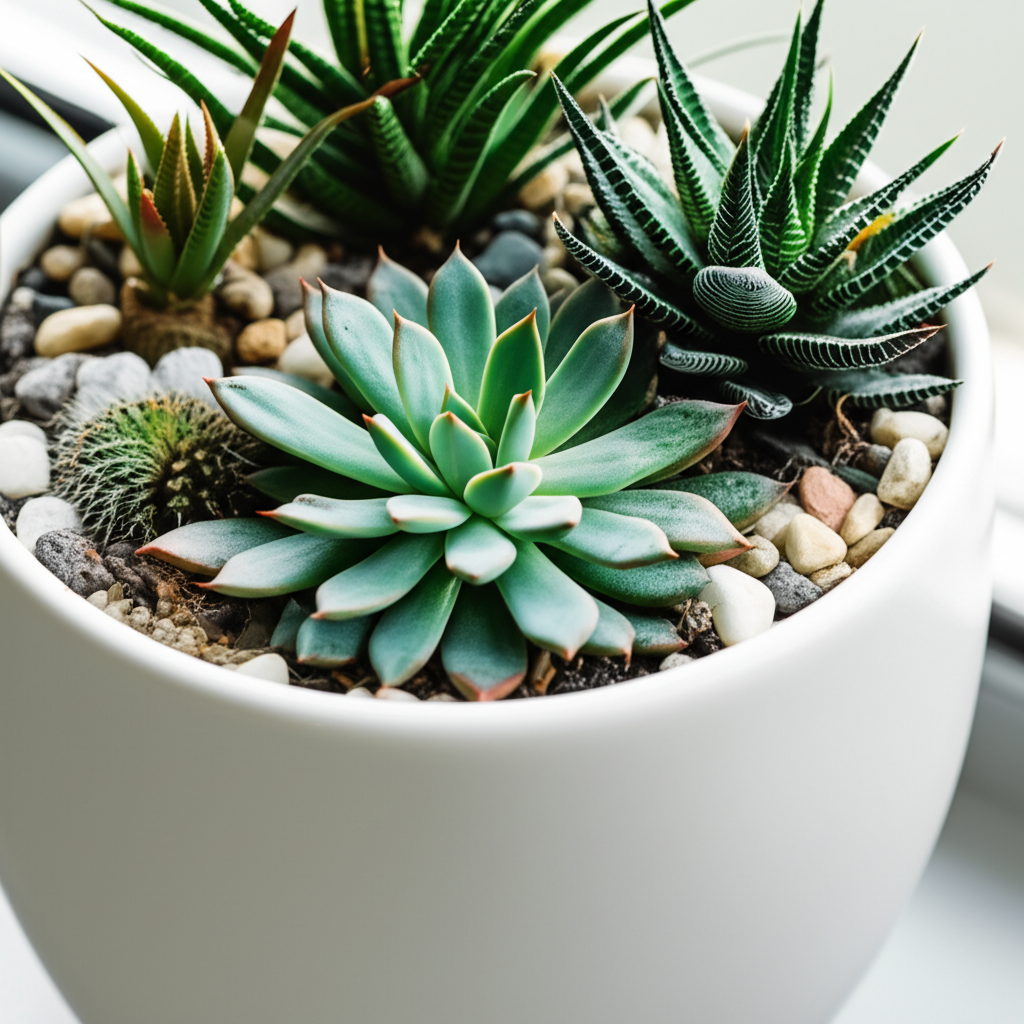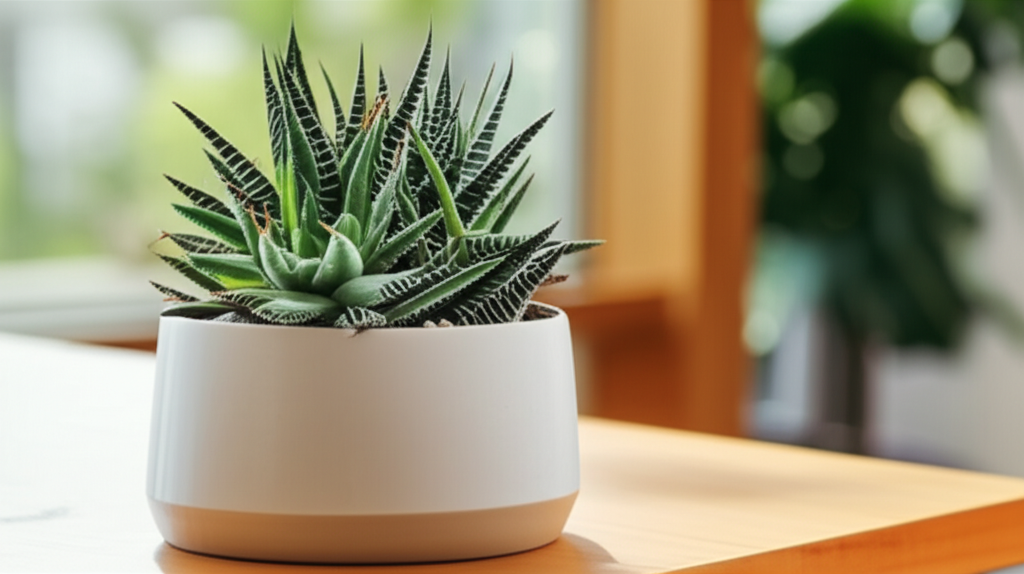Introduction: The Allure of the Ice Plant
Succulents have taken the interior design world by storm, and among their ranks, the Ice Plant (family Aizoaceae, often referred to as Mesembryanthemaceae) stands out for its unique charm and striking appearance. Known for their glistening, crystalline epidermal cells that resemble ice crystals, these plants offer a captivating textural element to any indoor space. Beyond their visual appeal, Ice Plants are remarkably resilient and relatively low-maintenance, making them an ideal choice for both seasoned plant enthusiasts and beginners alike. This guide will delve into the world of Ice Plant succulent arrangements, exploring their characteristics, care requirements, and how to create visually stunning displays that will elevate your home décor.
Understanding the Ice Plant: More Than Just a Pretty Face

The term “Ice Plant” is a broad descriptor encompassing a diverse genus of succulents, most notably Mesembryanthemum. These plants are native to arid regions of South Africa, where they have evolved fascinating adaptations to survive harsh conditions. Their most distinctive feature is the presence of specialized, water-filled bladder cells, called papillae or vesicles, on their leaves and stems. These papillae serve multiple purposes:
- Water Storage: They help the plant retain precious moisture in its arid environment.
- Sun Protection: The translucent nature of these cells can diffuse intense sunlight, protecting the underlying tissues from damage.
- Reflection: They can reflect excess sunlight, further aiding in temperature regulation.
- “Dew” Collection: In some species, the papillae can collect moisture from the air, supplementing their water intake.
This unique cellular structure gives the Ice Plant its characteristic shimmering or “frosted” appearance, which is particularly noticeable when light hits the plant at different angles.
Popular Ice Plant Varieties for Indoor Arrangements
While the general characteristics apply, different species offer subtle variations in form, color, and the intensity of their “ice” effect. Some popular choices for indoor arrangements include:
- Mesembryanthemum crystallinum (Common Ice Plant): This is the archetypal Ice Plant, known for its sprawling growth habit and the abundant, jewel-like papillae that give it a truly frosty appearance. It often produces delicate white or pink flowers.
- Delosperma cooperi (Hardy Ice Plant): While often grown outdoors, certain Delosperma varieties can thrive indoors. They are known for their vibrant magenta or pink daisy-like flowers and succulent, cylindrical leaves.
- Lithops (Living Stones): While not strictly “Ice Plants” in the common nomenclature, Lithops belong to the same family and are renowned for their incredible camouflage, mimicking pebbles and stones. Their fused leaf pairs are often covered in translucent “windows” that allow light to penetrate for photosynthesis.
- Conophytum species: Similar to Lithops, these miniature succulents are often grouped with pebble plants. They form dense clusters of small, fused leaf bodies, many of which possess translucent tops.
When selecting plants for your arrangement, consider the growth habits and aesthetic of these different varieties to create a dynamic and visually appealing composition.
Key Facts About Ice Plants for Indoor Cultivation
To successfully cultivate and arrange Ice Plants indoors, understanding their specific needs is crucial. Here’s a breakdown of essential information:
| Factor | Requirement | Notes |
|---|---|---|
| Light: | Bright, indirect sunlight. At least 6 hours per day. | Direct, intense sun can scorch some varieties. South or West-facing windows are ideal. |
| Watering: | Infrequent, but thorough. Allow soil to dry out completely between waterings. | Overwatering is the most common cause of root rot. Water less in winter. |
| Soil: | Well-draining, gritty mix. | Cactus or succulent potting mix is recommended. Add perlite or pumice for improved drainage. |
| Temperature: | Average room temperatures (65-80°F / 18-27°C). | Tolerant of slightly cooler temperatures in winter (down to 50°F / 10°C) but avoid frost. |
| Humidity: | Low. | These plants are adapted to dry climates and do not require high humidity. |
| Fertilizing: | Sparingly, during the growing season (spring/summer). | Use a diluted succulent or cactus fertilizer once a month. |
| Potting: | Pots with drainage holes are essential. | Terracotta pots are excellent for succulents due to their porosity. |
Designing Your Ice Plant Succulent Arrangement
Creating a beautiful Ice Plant arrangement is a rewarding process that involves understanding principles of design and plant selection. The goal is to create a cohesive and visually appealing display that highlights the unique textures and forms of your chosen succulents.
Choosing the Right Container
The container is the foundation of your arrangement. Consider the following:
- Material: Terracotta, ceramic, or even concrete containers work well. Ensure they have drainage holes.
- Size and Shape: Opt for shallow, wide containers like bowls, troughs, or shallow planters. These mimic the natural habitat of many succulents and provide ample surface area for planting.
- Style: Choose a container that complements your interior décor. Rustic, modern, or minimalist styles can all work beautifully.
Selecting Complementary Succulents
While the Ice Plant might be the star, incorporating other succulents can add depth, contrast, and interest to your arrangement. When selecting companion plants, consider:
- Texture: Mix plants with smooth, fleshy leaves alongside the textured, crystalline leaves of the Ice Plant. Examples include Echeverias, Sempervivums, and Haworthias.
- Color: Incorporate succulents with different colors – blues, purples, reds, and variegations – to create a vibrant palette. Sedums and Graptopetalums offer a range of colors.
- Form: Combine upright, rosette-forming, and trailing succulents for a dynamic composition. A trailing Sedum or Senecio can cascade over the edge of the pot.
- Growth Habit: Select plants with similar light and watering needs to ensure the health of the entire arrangement. Avoid mixing plants with vastly different requirements.
Arrangement Techniques
There are several popular approaches to arranging succulents:
- Focal Point: Place a larger or more distinctive Ice Plant in the center of the arrangement, with smaller succulents artfully placed around it.
- Layering: Use taller succulents in the back and shorter ones in the front, creating a sense of depth.
- Color Blocking: Group succulents of similar colors together for a bold visual impact.
- Texture Play: Emphasize the contrast between the icy texture of the Ice Plant and smoother-leaved succulents.
- Creeping Effect: Allow trailing succulents to spill over the edges of the container, creating a natural, cascading look.
When planting, gently remove succulents from their nursery pots, loosen any tightly bound roots, and arrange them in the container, filling any gaps with your well-draining succulent mix. Top dressing with decorative gravel or pebbles can enhance the aesthetic and help retain soil moisture.
Caring for Your Ice Plant Arrangement
Once your beautiful arrangement is complete, consistent and appropriate care is essential for its longevity and continued visual appeal.
Light Requirements
As mentioned earlier, Ice Plants thrive in bright, indirect sunlight. Place your arrangement near a south or west-facing window. If natural light is insufficient, consider using a grow light. Insufficient light can lead to leggy growth and a loss of the characteristic “ice” effect.
Watering Strategies
Overwatering is the primary enemy of succulents. The “soak and dry” method is ideal:
- When the soil feels completely dry to the touch (you can test this by sticking your finger about an inch into the soil), water thoroughly until water drains from the bottom of the pot.
- Allow the pot to drain completely and do not let it sit in standing water.
- Reduce watering significantly during the cooler winter months when plant growth slows down.
Soil and Drainage
The importance of well-draining soil cannot be overstated. A gritty, fast-draining mix ensures that excess water can escape, preventing root rot. If your potting mix seems too dense, amend it with perlite or pumice.
Pest and Disease Management
Ice Plants are generally pest-resistant. However, occasionally they may be susceptible to common succulent pests like mealybugs or spider mites.
- Mealybugs: Small, cottony white insects that cluster in leaf axils. Treat by dabbing with a cotton swab dipped in rubbing alcohol or by using an insecticidal soap.
- Spider Mites: Tiny red or brown mites that spin fine webs. Increase humidity slightly around the plant (though not excessively) and treat with insecticidal soap or neem oil.
Ensure good air circulation around your arrangement to minimize the risk of fungal diseases, which can occur in overly humid or stagnant conditions.
Pruning and Maintenance
Regularly inspect your arrangement for any dead or yellowing leaves and remove them to maintain a tidy appearance and prevent potential disease. Some Ice Plant varieties may become leggy over time; pruning can encourage bushier growth and can even be used to propagate new plants. Cuttings can be allowed to callous over for a few days before being planted in well-draining soil.
Troubleshooting Common Issues
Even with diligent care, you might encounter a few common issues. Understanding the causes and solutions can help keep your arrangement healthy.
| Problem | Cause | Solution |
|---|---|---|
| Mushy, Yellowing Leaves | Overwatering, poor drainage, or root rot. | Allow soil to dry out completely. If root rot is suspected, unpot the plant, trim away any black or mushy roots, and repot in fresh, dry, well-draining soil. |
| Stretching (Etiolation) | Insufficient light. | Move the arrangement to a brighter location with more indirect sunlight. Consider using a grow light. |
| Brown, Crispy Spots on Leaves | Sunburn from excessive direct sunlight. | Move the arrangement to a spot with bright, indirect light. If the spots are minor, the plant may recover. |
| Lack of “Ice” Effect | Insufficient light or plant stress. | Ensure the plant is receiving adequate bright light. Healthy, well-hydrated plants will show the best “ice” effect. |
| Pest Infestation | Mealybugs, spider mites. | Treat with appropriate methods as described in the pest management section. Isolate affected plants to prevent spread. |
The Benefits of Ice Plant Arrangements in Your Home
Beyond their striking beauty, incorporating Ice Plant succulent arrangements into your home offers several advantages:
- Air Purification: Like many houseplants, succulents can help filter indoor air by absorbing carbon dioxide and releasing oxygen.
- Stress Reduction: Studies have shown that the presence of plants can reduce stress and improve overall well-being. The calming aesthetic of succulents contributes to this effect.
- Aesthetic Enhancement: Their unique textures and forms add a sophisticated and natural element to interior décor, making a statement in any room.
- Low Maintenance: For busy individuals, the relatively low-maintenance needs of Ice Plants make them an accessible way to bring nature indoors.
- A Touch of Nature: In urban environments or during colder months, bringing these drought-tolerant beauties indoors provides a connection to the natural world.
Conclusion: Cultivating a Thriving Display
Ice Plant succulent arrangements offer a captivating blend of unique aesthetics and resilient nature, making them a perfect addition to any indoor space. By understanding their specific needs for light, water, and soil, and by carefully selecting complementary plants and containers, you can create stunning displays that will be admired for seasons to come. Embrace the art of succulent arrangement and let the shimmering beauty of the Ice Plant transform your home into a tranquil and visually rich oasis. Remember to observe your plants, adjust care as needed, and most importantly, enjoy the process of cultivating these remarkable plants.


